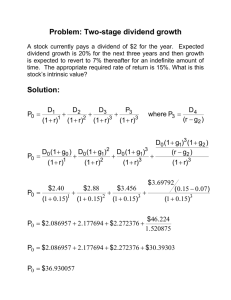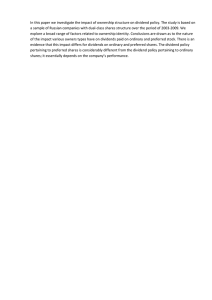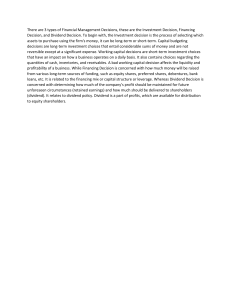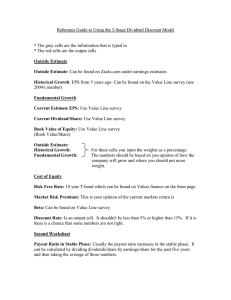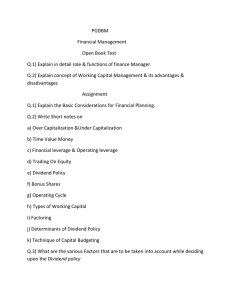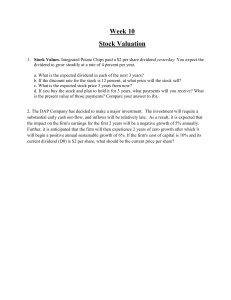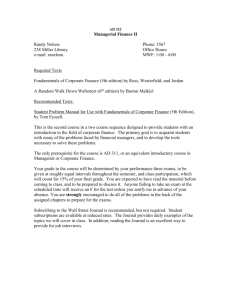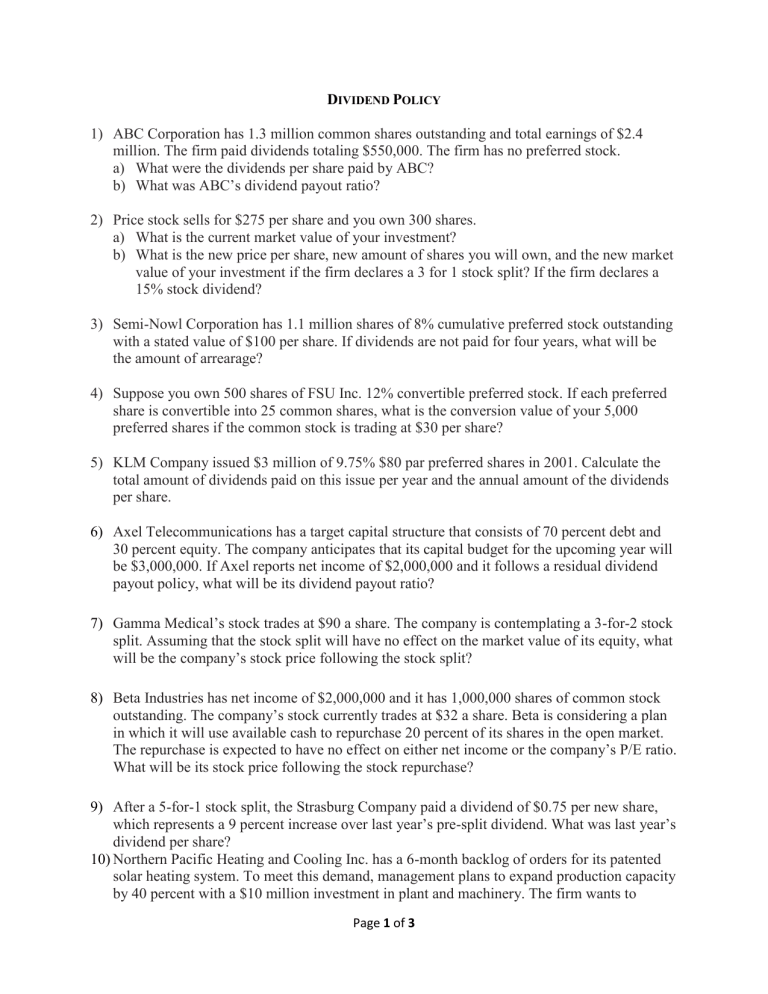
DIVIDEND POLICY 1) ABC Corporation has 1.3 million common shares outstanding and total earnings of $2.4 million. The firm paid dividends totaling $550,000. The firm has no preferred stock. a) What were the dividends per share paid by ABC? b) What was ABC’s dividend payout ratio? 2) Price stock sells for $275 per share and you own 300 shares. a) What is the current market value of your investment? b) What is the new price per share, new amount of shares you will own, and the new market value of your investment if the firm declares a 3 for 1 stock split? If the firm declares a 15% stock dividend? 3) Semi-Nowl Corporation has 1.1 million shares of 8% cumulative preferred stock outstanding with a stated value of $100 per share. If dividends are not paid for four years, what will be the amount of arrearage? 4) Suppose you own 500 shares of FSU Inc. 12% convertible preferred stock. If each preferred share is convertible into 25 common shares, what is the conversion value of your 5,000 preferred shares if the common stock is trading at $30 per share? 5) KLM Company issued $3 million of 9.75% $80 par preferred shares in 2001. Calculate the total amount of dividends paid on this issue per year and the annual amount of the dividends per share. 6) Axel Telecommunications has a target capital structure that consists of 70 percent debt and 30 percent equity. The company anticipates that its capital budget for the upcoming year will be $3,000,000. If Axel reports net income of $2,000,000 and it follows a residual dividend payout policy, what will be its dividend payout ratio? 7) Gamma Medical’s stock trades at $90 a share. The company is contemplating a 3-for-2 stock split. Assuming that the stock split will have no effect on the market value of its equity, what will be the company’s stock price following the stock split? 8) Beta Industries has net income of $2,000,000 and it has 1,000,000 shares of common stock outstanding. The company’s stock currently trades at $32 a share. Beta is considering a plan in which it will use available cash to repurchase 20 percent of its shares in the open market. The repurchase is expected to have no effect on either net income or the company’s P/E ratio. What will be its stock price following the stock repurchase? 9) After a 5-for-1 stock split, the Strasburg Company paid a dividend of $0.75 per new share, which represents a 9 percent increase over last year’s pre-split dividend. What was last year’s dividend per share? 10) Northern Pacific Heating and Cooling Inc. has a 6-month backlog of orders for its patented solar heating system. To meet this demand, management plans to expand production capacity by 40 percent with a $10 million investment in plant and machinery. The firm wants to Page 1 of 3 maintain a 40 percent debt-to-total-assets ratio in its capital structure; it also wants to maintain its past dividend policy of distributing 45 percent of last year’s net income. In 2005, net income was $5 million. How much external equity must Northern Pacific seek at the beginning of 2006 to expand capacity as desired? Assume the firm uses only debt and common equity in its capital structure. 11) The Welch Company is considering three independent projects, each of which requires a $5 million investment. The estimated internal rate of return (IRR) and cost of capital for these projects are presented here: Project H (high risk): Project M (medium risk): Project L (low risk): Cost of capital = 16%; Cost of capital = 12%; Cost of capital = 8%; IRR = 20% IRR = 10% IRR = 9% Note that the projects’ costs of capital vary because the projects have different levels of risk. The company’s optimal capital structure calls for 50 percent debt and 50 percent common equity. Welch expects to have net income of $7,287,500. If Welch establishes its dividends from the residual model, what will be its payout ratio? 12) Bowles Sporting Inc. is prepared to report the following income statement (shown in thousands of dollars) for the year 2006. $15,20 Sales 0 Operating costs including depreciation 11,900 EBIT $ 3,300 Interest 300 EBT $ 3,000 Taxes (40 percent) 1,200 Net income $ 1,800 Prior to reporting this income statement, the company wants to determine its annual dividend. The company has 500,000 shares of stock outstanding and its stock trades at $48 per share. a. The company had a 40 percent dividend payout ratio in 2005. If Bowles wants to maintain this payout ratio in 2006, what will be its per-share dividend in 2006? b. If the company maintains this 40 percent payout ratio, what will be the current dividend yield on the company’s stock? c. The company reported net income of $1.5 million in 2005. Assume that the number of shares outstanding has remained constant. What was the company’s per-share dividend in 2005? d. As an alternative to maintaining the same dividend payout ratio, Bowles is considering maintaining the same per-share dividend in 2006 that it paid in 2005. If it chooses this policy, what will be the company’s dividend payout ratio in 2006? e. Assume that the company is interested in dramatically expanding its operations and that this expansion will require significant amounts of capital. The company would like to avoid Page 2 of 3 transactions costs involved in issuing new equity. Given this scenario, would it make more sense for the company to maintain a constant dividend payout ratio or to maintain the same per-share dividend? 13) Rubenstein Bros. Clothing is expecting to pay an annual dividend per share of $0.75 out of annual earnings per share of $2.25. Currently, Rubenstein Bros.’ stock is selling for $12.50 per share. Adhering to the company’s target capital structure, the firm has $10 million in assets, of which 40 percent is funded by debt. Assume that the firm’s book value of equity equals its market value. In past years, the firm has earned a return on equity (ROE) of 18 percent, which is expected to continue this year and into the foreseeable future. a. Based on this information, what long-run growth rate can the firm be expected to maintain? (Hint: g Retention rate ROE.) b. What is the stock’s required return? c. If the firm were to change its dividend policy and pay an annual dividend of $1.50 per share, financial analysts predict that the change in policy will have no effect on the firm’s stock price or ROE. Therefore, what must the firm’s new expected long run growth rate and required return be? d. Suppose instead that the firm has decided to proceed with its original plan of disbursing $0.75 per share to shareholders, but the firm intends to do so in the form of a stock dividend rather than a cash dividend. The firm will allot new shares based on the current stock price of $12.50. In other words, for every $12.50 in dividends due to shareholders, a share of stock will be issued. How large will the stock dividend be relative to the firm’s current market capitalization? (Hint: Remember market capitalization P0 number of shares outstanding.) e. If the plan in part d is implemented, how many new shares of stock will be issued, and by how much will the company’s earnings per share be diluted? Page 3 of 3
